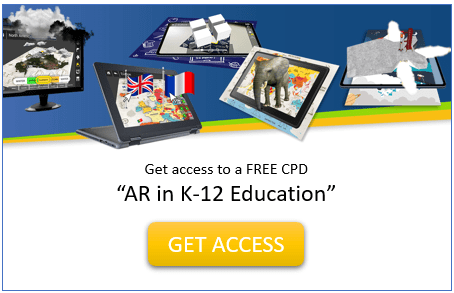Reading time: 7 minutes
Intro
It has always been known that human beings learn through experiences and grow through meaningful experiences. We look back at our life and remember the out of the ordinary things that happened which have shaped our character. What better way to educate our youth than by providing inspiring, interactive experiences that stimulate their natural curiosity for learning and exploration?
Augmented Reality [AR] was first conceptualized with interactivity as the core component; once its application bridged to education, the most visionary in the field foresaw the immense potential this technology would have in increasing student engagement, information retention, and creativity.
Multi-sensory learning enables students to think in multiple dimensions. If students can interact with the subjects they are learning, these will naturally become easier to grasp, and master
Let’s explore a few examples of AR’s educational benefits for students with different learning modalities:

Explaining complex concepts and theorems is a challenge for any instructor, AR enabled teaching makes this simple and effective. You can see any geometric object in a 3D space in the real world, in real time, making it easy for students to understand the object’s particularities and applications.You could think that this facilitation impedes creativity since students are seeing 3D models in front of them, instead of imagining them, but it actually creates a foundation on which to build upon: by seeing a complex geometric shape as it is in real life, factual, no nonsense [e.g a Torus], they can then use their unique creativity to imagine real life applications.
2) Auditory learning
Quality AR solutions know that for a student to learn at a deeper level, different senses must be stimulated. Auditory elements, from hearing a rocket launch into space, to a roaring tiger, can cement knowledge.
We perceive the world through our 5 senses, so for AR to be truly engaging and interactive, different senses need to be stimulated. When there is an AR concept in place, this technology can go leaps and bounds beyond what a textbook can offer in terms of interactivity.
3) Kinesthetic learning
Using the body’s tactile awareness to learn is effective, especially with kids. With CleverBooks, students can explore STEM subjects through their own hands, from the solar system, to geometric objects, to weather fluctuation in different continents.
Taking students on a multisensory educational journey is visionary in 2021, but will become a standard if we want to effectively prepare our youth for the 21st century work-force.
Bonus benefit: Cost & Implementation effectiveness
An advantage of AR, in particular CleverBooks’, is it’s cost-effectiveness and ease of implementation, which makes it a breeze for schools to adopt:
– No need for expensive gear such as headsets, or extra unnecessary lab equipment, just software to download on a PC, ChromeBook, or mobile device [Tablet, Smartphone].
– No need to learn programming or go through long courses to implement the tool with students. Teachers can creatively grasp how to use the technology almost immediately after trying it.
Experience how AR will benefit students with different learning predispositions for yourself by trying out the best Augmented Reality Education Apps for free: https://www.augmented-classroom.com/

